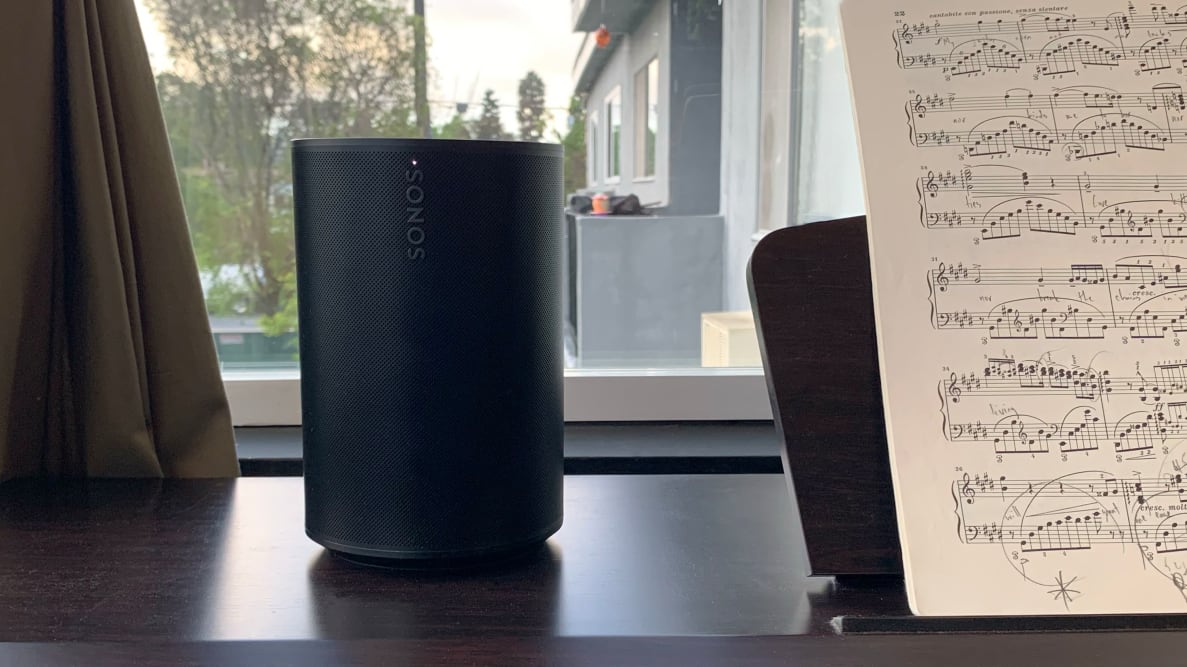Pros
-
Excellent, full sound
-
Plethora of music apps
-
Attractive design
Cons
-
Sonos app is cumbersome at times
-
Stereo effect is lackluster
Editor's Update Note (March 30, 2023): Google Assistant is not supported by Sonos and a recent app update has removed it as an option during voice assistant setup. We have removed it from the review.
The Era 100 is one of two new wireless speakers from Sonos—the second being the Sonos Era 300 for $449. Both the Era 300 and Era 100 support Bluetooth 5.0 and Apple AirPlay, can be used as rear speakers in a Sonos home theater setup, and use the Sonos app to access a multitude of music streaming apps.
About the Sonos Era 100
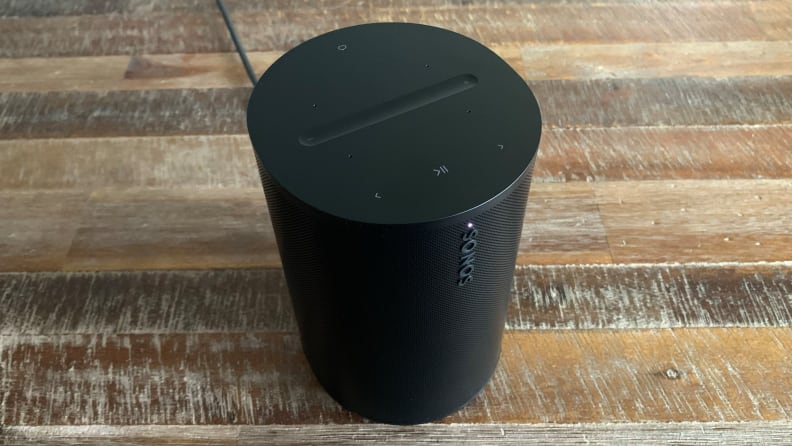
Setup and tuning for the Sonos Era 100 is fast and easy with the Sonos app.
- Price: $249
- Dimensions (HWD): 7.18 x 4.72 x 5.14 inches
- Weight: 4.44 lbs
- Colors: Black, White
- Speakers/drivers: Two angled tweeters, one mid-woofer
- Amplification: Three Class-D amplifiers
- Wireless Connection: Wi-Fi 6 (802.11 a/b/g/n/ac/ax, 2.4GHz/5GHz), Bluetooth 5.0
- Wired Connection: USB-C, 3.5mm with optional line-in adapter, Ethernet with optional combo adapter
- Smart Assistants: Amazon Alexa, Sonos Voice Control
- Special features: Apple AirPlay 2
Sonos has been a sustainability-conscious company for a while now, and that consideration continues with the new Era lineup. The Era 100 itself is made up of 48% post-consumer recycled plastics and the packaging is 100% recyclable—even the cable wraps are made of paper. Plus, at the launch event Sonos revealed it’s decreased power usage in idle mode to less than 2 watts. Sonos has also moved away from using adhesives for assembly, instead relying on screws to make factory maintenance and part replacement easier and faster.
The Era 100 comes with just a power cable. All setup requires the Sonos app, available for both iOS and Android, and a Wi-Fi connection. Trueplay allows for custom tuning to your space, which I discuss more below. There’s also an incredible wealth of streaming apps that can be connected to your Sonos ecosystem, including Amazon Music, Sonos Radio, Apple Music, Spotify, Tidal, Calm, Deezer, iHeartRadio, and Pandora. In total there are 96 music streaming services integrated in the Sonos app at the time of the speaker’s release.
Sonos has optional speaker stands and wall mounts available for the Era 100 that come in both black and white to match the color of the speaker. Sanus also offers an Era 100 stand with a square base as opposed to the round one from Sonos.
What we like
Room-filling robust sound

The compact design of the Sonos Era 100 (right) fits beautifully on your bookshelf, kitchen counter, desk, or nightstand.
The achilles heel of most small smart speakers is their ability to fill a room with sound that isn’t thin or harsh. Such weakness doesn’t befall the Sonos Era 100. The speaker has a woofer and two angled tweeters (up from just one in the One) with custom waveguides for wider dispersion.
After running Trueplay to tune the speaker to my space, my living room was awash with rich sound. There’s more than enough power to fill a moderately sized room. At full volume and about 10 feet away, I measured an average level of around 75dB, about the same volume as a vacuum cleaner. For more reference, mixing engineers calibrate their spaces from their listening position to anywhere between 72 and 85dB depending on the size of the room. I rarely found the need to have the Era 100 playing that loud, but when I did the sound was still balanced and not oppressive. If you’re concerned about the volume getting too high from an errant swipe of the speaker’s volume control, there’s a volume limiter in the app where you can set the max to any percentage of full volume.
I found Trueplay tuning to be far preferable to the out-of-the-box sound, which isn’t that surprising since it uses advanced processing to calibrate to your room’s acoustics. For iOS users, there are two levels of Trueplay—Quick tuning that uses the built-in microphone to assess the room acoustics in a matter of seconds, and Advanced tuning which requires you to slowly wave your iOS device around as you pace the confines of your room for 45 seconds. And now Android users can access Trueplay, but just the Quick version.
The two tuning options were remarkably similar in my room, so Android users aren’t missing out on much, although I could see the benefit to running the Advanced tuning when using two Era 100 speakers as a stereo pair, and certainly if they’re used as rear speakers in a home theater surround sound setup.
The Era 100 is able to deliver really nice vocal clarity through a rich midrange and supportive low end. Even with “Zombie” by the Cranberries—a compressed track that gets thick and busy—Dolores O’Riordan’s distinctive vocals cut through without being piercing or too forward. Music through the speaker is a joy to listen to.
Improved bass response
While this is a continuation of the room-filling robust sound, the bass really deserves its own callout. For such a small speaker, the Era 100 has impressive bass response. It’s a great improvement over the Sonos One and is partly due to the larger woofer size, an increase of 25% over the One.
Trueplay tuning delivered significantly better bass, an improvement that can be heard by toggling it on and off in the Sonos app. There’s an increased warmth to the low end and everything sounds fatter and better supported. For my ears, the bass tended to be a bit much. I backed it off one click in the two-band EQ, but if that EQ adjustment wasn’t available to me, I would have been more than happy with the Trueplay result.
Attractive design and more connectivity
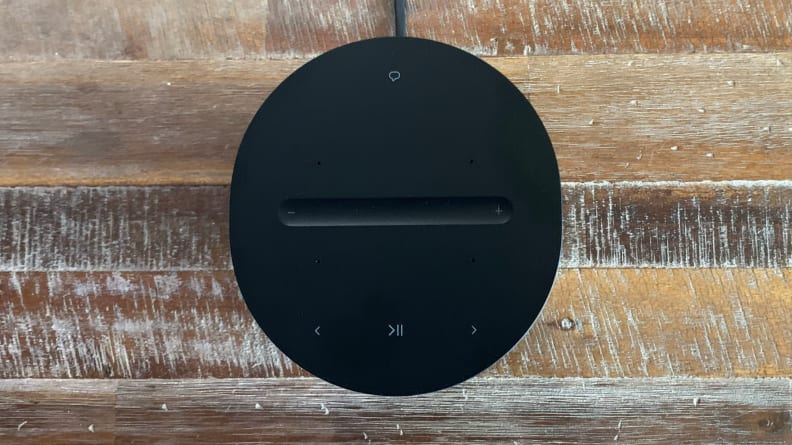
Capacitive touch controls on the top of the Sonos Era 100 allow for track navigation and volume control.
The Sonos Era 100’s footprint is marginally bigger than the slightly boxy looking One (although it’s about three quarters of an inch taller), with a cylindrical shape, small vertical Sonos badge, and wraparound grille that covers all but the very back of the speaker. Even with the extra height, it’s a sleeker design than the One.
The controls on the top have a clean look with capacitive transport buttons, a voice assistant activation button, and an indented strip to raise or lower volume with a swipe. The controls are intuitive if you choose to walk over and use them. I found myself browsing tracks and controlling volume more in the app than with the controls, though.
One of the biggest complaints about the Sonos One was its lack of connectivity, which kept it from being the best smart speaker. That’s not an issue with the Era 100. The speaker supports Bluetooth connectivity with a pairing button on the back. It’s just below the top edge of the speaker and easy to press whenever you want to connect a new device. There are also two optional adapters—one with line-in only and one with Ethernet and line-in—to connect something directly to the speaker. If you have multiple Sonos speakers in your home, anything connected to the Era 100 can then be played through any networked speaker.
Smart mic can be disconnected
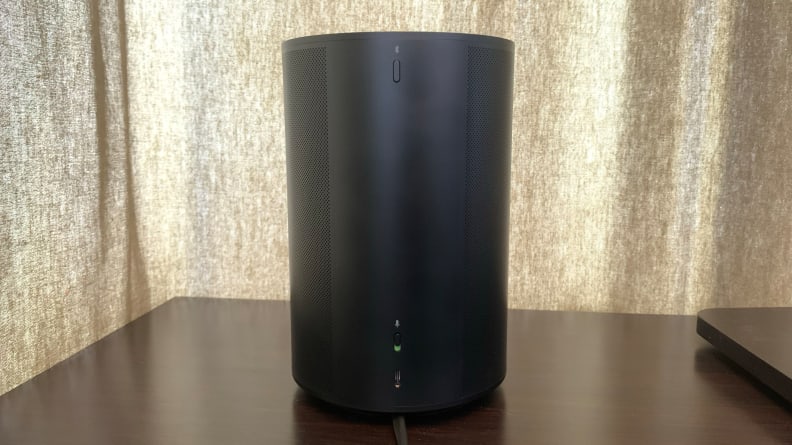
A toggle on the back on the Sonos Era 100 allows you to shut off power to the built-in microphone.
Having an interconnected world is extraordinarily helpful for our productivity and convenience, but there’s rightful concern as to how we can still protect our privacy when we want to. Built-in, always-listening microphones for smart assistants can cause uneasiness even though the full functionality of services such as Amazon Alexa rely upon them.
The Era 100 supports the use of Sonos Voice Control and Amazon Alexa. If the idea of an always-listening microphone irks you, there’s a switch on the back of the speaker that physically disconnects the connection, as opposed to just turning it off. The switch is easily accessible and identifiable (it’s the only one towards the speaker’s base), so turning it off while planning your Vegas heist is a quick endeavor.
What we don’t like
Sonos app can be cumbersome
There’s a lot that can be done with the Sonos app: dozens of available streaming apps; support for Alexa and Sonos smart assistants; and the ability to play music throughout your home in any configuration and easily change it as you move to different rooms. But having all of that functionality in one place can be unwieldy and the streaming services in the Sonos app don’t always perform as smoothly as they do with their native interfaces. It’s understandable, considering how many options there are that all need integration, but it doesn’t change the fact it can occasionally be frustrating.
Stereo effect lacking
The idea of using two angled tweeters in a single speaker enclosure to deliver stereo sound is a solid one. In practice, though, the performance isn’t enough to be a selling point for the Era 100. There is a mild sense of separation between the left and right channels in tracks that have wide placement and motion—”Such Great Heights” by Postal Service for example—but it really requires you to be sitting in the sweet spot. When moving around a room, there’s no real stereo effect apparent. I tried multiple tracks on different services with both Trueplay tunings to no avail.
One thing the stereo tweeters certainly help with is the overall space the sound can fill. But if you’re looking for distinct stereo imaging you’ll need to pair another Era 100 and set them up as a stereo pair in the app.
Should you buy the Sonos Era 100?
Yes, especially if you’re considering the Sonos ecosystem
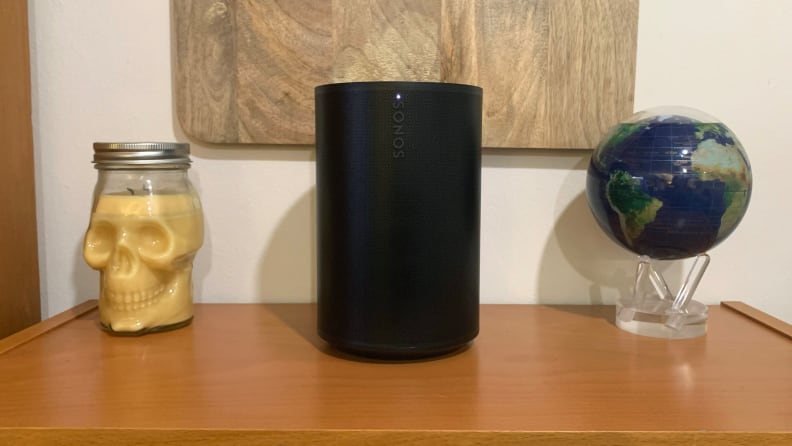
Stream high quality audio from anywhere in your home without interruptions from calls or notifications.
The Sonos Era 100 is the new smart speaker to beat thanks to its excellent sound, vast array of music app options, Sonos whole-home connectivity, and the addition of Bluetooth.
Its stereo separation leaves a bit to be desired, but I have yet to hear a small single speaker that delivers much more than the Era 100 in that regard. If the Sonos ecosystem is not for you, the Bose Home Speaker 300 has all of the same connectivity as the Era 100 without the need of a pesky adapter and has a great selection of streaming apps available for music. But the Sonos is more attractive, has better sound quality, and is less expensive than the Bose.
If you want to sit and enjoy your favorite music in stereo, two Era 100 speakers can be paired together to deliver a true stereo image. The Era 300 also provides a more convincing stereo experience than a single Era 100 with the added benefit of spatial audio support, although for an extra $200.
Sonos has reached a new echelon with the Era 100, adding features that were missing from previous models and improving sound quality. It’s worth the upgrade for existing Sonos fans and is certain to win over a few more.
Meet the tester
John is Reviewed's Managing Editor of Tech. He is an ISF Level III-certified calibrator with bylines at ProjectorCentral, Wirecutter, IGN, Home Theater Review, T3, Sound & Vision, and Home Theater Magazine. When away from the Reviewed office, he is a sound editor for film and musician, and loves to play games with his son.
Checking our work.
Our team is here for one purpose: to help you buy the best stuff and love what you own. Our writers, editors, and lab technicians obsess over the products we cover to make sure you're confident and satisfied. Have a different opinion about something we recommend? Email us and we'll compare notes.
Shoot us an email
